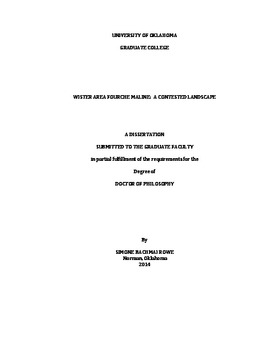| dc.contributor.advisor | Rankin-Hill, Lesley | |
| dc.contributor.advisor | Wyckoff, Don | |
| dc.contributor.author | Rowe, Simone | |
| dc.date.accessioned | 2014-05-22T15:27:52Z | |
| dc.date.available | 2014-05-22T15:27:52Z | |
| dc.date.issued | 2014-05-09 | |
| dc.identifier.uri | https://hdl.handle.net/11244/10438 | |
| dc.description.abstract | The Wister area of southeastern Oklahoma was a contested landscape during the Fourche Maline (Late Woodland cultural period). This claim is supported by paleopathological evidence for high rates of skeletal trauma and bioarchaeological evidence for high rates of group and mass burials. Feuding appears to have been rampant with high levels of traumatic death (group burials) and trophy-taking behavior. The contested landscape impacted residents of the valley in multiple ways. In addition to loss of life for both adults and children and the physical trauma from fractured bones and projectile points, the residents of the valley suffered from probable significant, though intermittent, intergenerational nutritional stress. This nutritional stress is hypothesized to be the result of a restricted diet that resulted from constricted hunting and gathering territories that were the consequences of widespread local feuding. | en_US |
| dc.language | en_US | en_US |
| dc.subject | Anthropology, Physical. | en_US |
| dc.title | Wister Area Fourche Maline: A Contested Landscape | en_US |
| dc.contributor.committeeMember | Warren, Diane | |
| dc.contributor.committeeMember | Livingood, Diane | |
| dc.contributor.committeeMember | Safiejko-Mroczka, Barbara | |
| dc.date.manuscript | 2014-05-09 | |
| dc.thesis.degree | Ph.D. | en_US |
| ou.group | College of Arts and Sciences::Department of Anthropology | |
